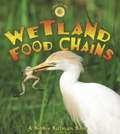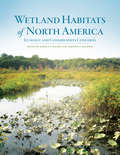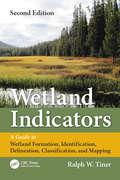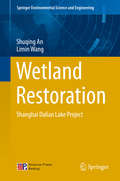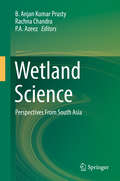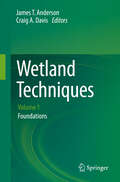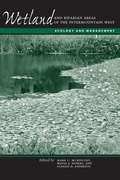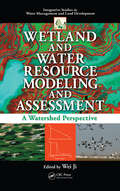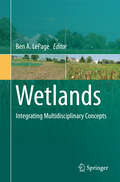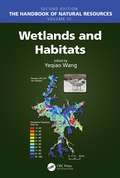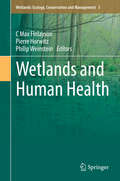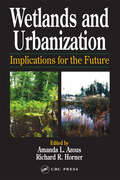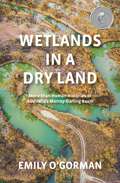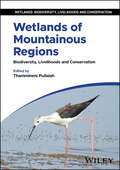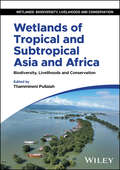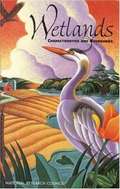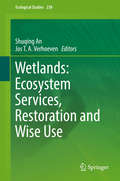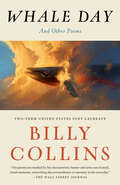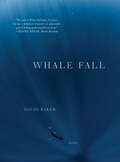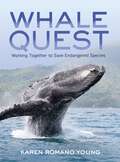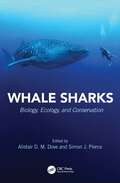- Table View
- List View
Wetland Food Chains (Food Chains)
by Bobbie Kalman Kylie BurnsA wide variety of plants and animals live, visit, and feed in wetlands, but wetlands are fast disappearing. This informative book describes life in a specific wetland--the marsh. Beautiful photographs, illustrations, and text explain which plants and animals live in this habitat and how they interact with one another. Young readers will learn about* wetland herbivores, carnivores, and omnivores* how wetland animals survive the changing seasons* the importance of wetlands to migrating animals* dangers to wetlands
Wetland Habitats of North America
by Andrew H. Baldwin Darold P. BatzerWetlands are prominent landscapes throughout North America. The general characteristics of wetlands are controversial, thus there has not been a systematic assessment of different types of wetlands in different parts of North America, or a compendium of the threats to their conservation. Wetland Habitats of North America adopts a geographic and habitat approach, in which experts familiar with wetlands from across North America provide analyses and synthesis of their particular region of study. Addressing a broad audience of students, scientists, engineers, environmental managers, and policy makers, this book reviews recent, scientifically rigorous literature directly relevant to understanding, managing, protecting, and restoring wetland ecosystems of North America.
Wetland Indicators: A Guide to Wetland Formation, Identification, Delineation, Classification, and Mapping, Second Edition
by Ralph W. TinerUnderstand the current concept of wetland and methods for identifying, describing, classifying, and delineating wetlands in the United States with Wetland Indicators - capturing the current state of science's role in wetland recognition and mapping.Environmental scientists and others involved with wetland regulations can strengthen their knowledge about wetlands, and the use of various indicators, to support their decisions on difficult wetland determinations. Professor Tiner primarily focuses on plants, soils, and other signs of wetland hydrology in the soil, or on the surface of wetlands in his discussion of Wetland Indicators.Practicing - and aspiring - wetland delineators alike will appreciate Wetland Indicators' critical insight into the development and significance of hydrophytic vegetation, hydric soils, and other factors. Features Color images throughout illustrate wetland indicators. Incorporates analysis and coverage of the latest Army Corps of Engineers delineation manual. Provides over 60 tables, including extensive tables of U.S. wetland plant communities and examples for determining hydrophytic vegetation.
Wetland Landscape Characterization: Practical Tools, Methods, and Approaches for Landscape Ecology, Second Edition
by John G. Lyon Ricardo D. Lopez Lynn K. Lyon Debra K. LopezWetlands are, by their very nature, ephemeral and transitional, which makes them challenging to characterize. Yet the need for characterizing wetlands continues to grow, particularly as we develop a better understanding of the wealth of ecosystem services that they provide. This book provides practical tools and methods to help practitioners more effectively locate, identify, and map the extent of wetlands, and therefore better understand the importance of wetlands to society and the larger landscape. The authors address jurisdictional, regulatory, and practical applications from the scientific, engineering, and lay perspectives. Numerous techniques, examples, figures, and lessons learned supply the ideas and solutions needed for solving the complex issues associated with wetlands. This second edition has been updated throughout and includes more techniques, examples, and illustrations.
Wetland Restoration
by Limin Wang Shuqing An"Wetland Restoration: Shanghai Dalian Lake Project" introduces the whole Shanghai DaLian wetland restoration project, including the background investigation of the wetland, the overall planning of wetland restoration, its detailed design, engineering construction and engineering effects. This book appeals to readers especially due to its detailed data on wetland restoration. Readers can carry out a similar project step by step from the initial investigation to the last assessment by following the structure presented in this work. Through this book, we can get first-hand information on a wetland restoration, but it can also be valuable for other projects. Professor Shuqing An works at Nanjing University, China.
Wetland Science
by B. Anjan Kumar Prusty Rachna Chandra P. A. AzeezThis book is an attempt to acknowledge the discipline 'wetland science' and to consolidate research findings, reviews and synthesis articles on different aspects of the wetlands in South Asia. The book presents 30 chapters by an international mix of experts in the field, who highlight and discuss diverse issues concerning wetlands in South Asia as case studies. The chapters are divided into different themes that represent broad issues of concern in a systematic manner keeping in mind students, researchers and general readers at large. The book introduces readers to the basics and theory of wetland science, supplemented by case studies and examples from the region. It also offers a valuable resource for graduate students and researchers in allied fields such as environmental studies, limnology, wildlife biology, aquatic biology, marine biology, and landscape ecology. To date the interdisciplinary field 'wetland science' is still rarely treated as a distinct discipline in its own right. Further, courses on wetland science aren't taught at any of the world's most prestigious universities; instead, the topics falling under this discipline are generally handled under the disciplines 'ecology' or under the extremely broad heading of 'environmental studies'. It is high time that 'Wetland Science' be acknowledged as an interdisciplinary sub-discipline, which calls for an attempt to consolidate its various subtopics and present them comprehensively. Thus, this book also serves as a reference base on wetlands and facilitates further discussions on specific issues involved in safeguarding a sustainable future for the wetland habitats of this region.
Wetland Techniques
by James T. Anderson Craig A. DavisWetlands serve many important functions and provide numerous ecological services such as clean water, wildlife habitat, nutrient reduction, and flood control. Wetland science is a relatively young discipline but is a rapidly growing field due to an enhanced understanding of the importance of wetlands and the numerous laws and policies that have been developed to protect these areas. This growth is demonstrated by the creation and growth of the Society of Wetland Scientists which was formed in 1980 and now has a membership of 3,500 people It is also illustrated by the existence of 2 journals (Wetlands and Wetlands Ecology and Management) devoted entirely to wetlands. To date there has been no practical, comprehensive techniques book centered on wetlands, and written for wetland researchers, students, and managers. This techniques book aims to fill that gap. It is designed to provide an overview of the various methods that have been used or developed by researchers and practitioners to study, monitor, manage, or create wetlands. Including many methods usually found only in the peer-reviewed or gray literature, this 3-volume set fills a major niche for all professionals dealing with wetlands.
Wetland and Riparian Areas of the Intermountain West: Ecology and Management
by Mark C. Mckinstry Wayne A. Hubert Stanley H. AndersonWetlands and riparian areas between the Rocky Mountains and the Sierra Nevada are incredibly diverse and valuable habitats.<P><P> More than 80 percent of the wildlife species in this intermountain region depend on these wetlands—which account for less than 2 percent of the land area—for their survival. At the same time, the wetlands also serve the water needs of ranchers and farmers, recreationists, vacation communities, and cities. It is no exaggeration to call water the "liquid gold" of the West, and the burgeoning human demands on this scarce resource make it imperative to understand and properly manage the wetlands and riverine areas of the Intermountain West.
Wetland and Water Resource Modeling and Assessment: A Watershed Perspective
by Wei JiAs a wetland of international importance located in China, the Poyang Lake Basin's incredible topographical and biological diversity has provided a congregating point for scientists from around the world to engage in cross-disciplinary research. In particular, the International Conference on Poyang Lake Complex Environment System was instrumental i
Wetlands
by Ben A. LepageThe science of wetlands and our understanding of these complex ecosystems have improved considerably. The emergence of multidisciplinary strategies is providing new opportunities and innovative approaches to address issues such as climate change and coastal protection. This book, with contributions from 19 specialists from academia, government, and industry, provides a trans-disciplinary approach to the understanding wetlands science, drawing together a wide range of expertise. Topics covered include the physical aspects that shape different wetlands around the world, as well as wetlands ecology, regulation, policy, and related social and economic issues. Featuring contributions from some of the world's leading wetlands researchers and practitioners, this book provides an invaluable resource for undergraduate and post-graduate training in all aspects of wetlands management, conservation, and construction. It is also a useful auxiliary text for researchers working across disciplines in fields such as wetlands science, law, landscape architecture, environmental engineering, conservation ecology, and related disciplines.
Wetlands and Habitats
by Yeqiao WangAuthored by world-class scientists and scholars, The Handbook of Natural Resources, Second Edition, is an excellent reference for understanding the consequences of changing natural resources to the degradation of ecological integrity and the sustainability of life. Based on the content of the bestselling and CHOICE-awarded Encyclopedia of Natural Resources, this new edition demonstrates the major challenges that the society is facing for the sustainability of all well-being on the planet Earth. The experience, evidence, methods, and models used in studying natural resources are presented in six stand-alone volumes, arranged along the main systems of land, water, and air. It reviews state-of-the-art knowledge, highlights advances made in different areas, and provides guidance for the appropriate use of remote sensing and geospatial data with field-based measurements in the study of natural resources. Volume 3, Wetlands and Habitats, provides fundamental information on wetlands and their integral functions as a productive ecosystem. The topics it covers include wetlands biodiversity, wetlands classification and monitoring, floods, river ecosystems, pollution, and more. New to this edition are discussions on wetland vegetation, assessment of current wetland health status, restoration, sea-level rises and coastal storm, vulnerability to human impacts, and lakes and wetlands remote sensing. This volume demonstrates the key processes, methods, and models used through many case studies from around the world. Written in an easy-to-reference manner, The Handbook of Natural Resources, Second Edition, as individual volumes or as a complete set, is an essential reading for anyone looking for a deeper understanding of the science and management of natural resources. Public and private libraries, educational and research institutions, scientists, scholars, and resource managers will benefit enormously from this set. Individual volumes and chapters can also be used in a wide variety of both graduate and undergraduate courses in environmental science and natural science at different levels and disciplines, such as biology, geography, earth system science, and ecology.
Wetlands and Human Health
by C Max Finlayson Pierre Horwitz Philip WeinsteinThe book addresses the interactions between wetlands and human health and well-being. A key feature is the linking of ecology-health and the targeting of practitioners and researchers. The environmental health problems of the 21st Century cannot be addressed by the traditional tools of ecologists or epidemiologists working in their respective disciplinary silos; this is clear from the emergence and re-emergence of public health and human well-being problems such as cholera pandemics, mosquito borne disease, and episodic events and disasters (e. g. hurricanes). To tackle these problems requires genuine cross-disciplinary collaboration; a key finding of the recently concluded Millennium Ecosystem Assessment when looking at human well-being and ecosystem health. This book brings the disciplines of ecology and health sciences closer to such a synthesis for researchers, teachers and policy makers interested in or needing information to manage wetlands and human health and well-being issues.
Wetlands and Lakes of the World
by Devashish KarThe occurrence and description of wetlands in India with reference to those around the world is detailed in a sequential manner from local, provincial, regional, and national to global scenario in this book, "Wetlands and Lakes of the World". The book also deals with a systematic, sequential and comprehensive treatment of the Limnology (physico-chemical and biological features) and Fisheries of the Wetlands in India and is well supported by author's original data. As Limnology and Fishery Science are interlinked, this book attempts to provide a holistic view of both the fields, along with their methodologies. The book has numerous examples from the local environment that go along with the explained theoretical concepts. Furthermore, a unique feature of the book is that it deals with the protocols of various Limnological methodologies, thus, making it a handy guide for lab and field studies. The book has distinguished itself by incorporating chapter based on Global Information System or GIS. The book also has an up to date Bibliography and summary at the end of each chapter with text on various aspects, particularly, generally not much dealt with aspects like fisherfolk, their fish catching devices, fishing centers, fish markets and, above all, their socio-economic conditions supported by author's original data. In Brief. . "Wetlands and Lakes of the World" is, a humble treatise to provide the undergraduates with a text concentrating on the common, fundamental features of all aquatic systems, and the for the postgraduates, researchers, policy makers, administrators, etc. with the details of processes and applications with examples.
Wetlands and Urbanization: Implications for the Future
by Amanda L. Azous Richard R. HornerUrbanization affects wetlands in direct and indirect ways. Over the past several decades it has become increasingly apparent that unmanaged runoff is the primary threat to the country's watershed resources. Wetlands and Urbanization: Implications for the Future is the result of a ten year research project focused on the understanding and ma
Wetlands and Water Framework Directive
by Stefan Ignar Mateusz GrygorukThis book compares the lessons learned from a wetland-perspective approach to the changing climate and the requirements of the Water Framework Directive (WFD) with regard to environmental conservation. Examples from Germany and Poland are discussed due to the efficiency of their respective implementations of water conservation policies. Although the general scientific interest in specific issues such as wetlands, climate change, nature conservation and the WFD enjoy a well established position in international environmental research, these four elements are rarely considered together due to the complexity of the processes, biased scenarios of global change and subjective policy background. Major challenges involved in carrying out environmental conservation actions that assess the potential impacts of climate change and management plans on water bodies are identified. The results of this approach are addressed to practitioners in the field of adaptive management in a wetlands context.
Wetlands in a Dry Land: More-than-Human Histories of Australia's Murray-Darling Basin
by Emily O'GormanWhat counts as a wetland, especially in Australia, the driest inhabited continent on earth? In the name of agriculture, urban growth and disease control, humans have drained, filled or otherwise destroyed nearly 87 percent of the world's wetlands over the past three centuries. Only recently have wetlands been widely recognised as worth preserving for their diverse plants, animals, insects, and their human histories. Examining Australia's own Murray-Darling Basin, environmental historian Emily O'Gorman shows how people and animals have shaped wetlands since the late nineteenth century. O'Gorman draws on archival research and original interviews to illuminate how Aboriginal peoples acted then and now as custodians of the landscape, how the movements of water birds affected farmers and how mosquitoes have defied efforts to fully understand, let alone control, them. Situating Australia's history within global environmental humanities conversations, O'Gorman argues that we need to understand wetlands as socioecological landscapes that transcend the nature-culture divide and to embrace non-Western ways of knowing and being. Only then can we begin to create sustainable relationships with, and futures for, the wetlands.
Wetlands of Mountainous Regions: Biodiversity, Livelihoods and Conservation (Wetlands: Biodiversity, Livelihoods and Conservation)
by Thammineni PullaiahA comprehensive survey of exemplary wetlands that highlights their importance for local livelihoods as well as for global biodiversity Covering 12 mountainous regions ranging from medium to high altitudes, Wetlands of Mountainous Regions provides detailed information on the world’s most important wetlands and wetland types across Eurasia and the Americas as well as their current and potential biological resources. Each wetland is analyzed by a regional expert. Written with UN sustainable development goals in mind, Wetlands of Mountainous Regions includes information on: Wetlands of Eastern Himalaya, Nepal, Pakistan, Armenia, Georgia, Slovakia, Bosnia, Herzegovina, Mexico, Costa Rica, Bolivia, Argentina, and SerbiaThe importance in sustaining local economic livelihoods of each wetland region by providing food resources as well as recreational opportunitiesWetland ecosystem services including carbon sequestration, water filtration, nutrient retention, and flood mitigationThreats to the integrity of each wetland region as well as management strategies and practical conservation and restoration measures Wetlands of Mountainous Regions is an essential reference on the subject for ecologists, conservation scientists, hydrologists, and environmental and water resource managers. Governmental agencies and professionals in fisheries, agriculture, and rural development will also find value in the book.
Wetlands of Tropical and Subtropical Asia and Africa: Biodiversity, Livelihoods and Conservation
by Thammineni PullaiahA comprehensive survey of exemplary wetlands that highlights their importance for local livelihoods as well as for global biodiversity Covering 17 different regions, Wetlands of Tropical and Subtropical Asia and Africa provides detailed information on some of the world’s most important wetlands and wetland types across those countries, as well as their current and potential biological resources. Each wetland is analyzed by a regional expert. Written with UN sustainable development goals in mind, Wetlands of Tropical and Subtropical Asia and Africa includes information on: Recommendations for the sustainable management of wetlands in the Asian and African tropicsThe importance of sustaining local economic livelihoods in each wetland region by providing food resources as well as recreational opportunitiesWetland ecosystem services including carbon sequestration, water filtration, nutrient retention, and flood mitigationThreats to the integrity of each wetland region as well as management strategies and practical conservation and restoration measures Wetlands of Tropical and Subtropical Asia and Africa is an essential reference on the subject for ecologists, conservation scientists, hydrologists, and environmental and water resource managers. Governmental agencies and professionals in fisheries, agriculture, and rural development will also find value in the book.
Wetlands: CHARACTERISTICS AND BOUNDARIES
by Committee on Characterization of WetlandsWetlands has become a hot word in the current environmental debate. But what does it signify? In 1991, proposed changes in the legal definities of wetlands stirred controversy and focused attention on the scientific and economic aspects of their management.This volume explores how to define wetlands. The committee--whose members were drawn from academia, government, business, and the environmental community--builds a rational, scientific basis for delineating wetlands in the landscape and offers recommendations for further action.Wetlands also discusses the diverse hydrological and ecological functions of wetlands, and makes recommendations concerning so-called controversial areas such as permafrost wetlands, riparian ecosystems, irregularly flooded sites, and agricultural wetlands. It presents criteria for identifying wetlands and explores the problems of applying those criteria when there are seasonal changes in water levels.This comprehensive and practical volume will be of interest to environmental scientists and advocates, hydrologists, policymakers, regulators, faculty, researchers, and students of environmental studies.
Wetlands: Ecosystem Services, Restoration and Wise Use (Ecological Studies #238)
by Shuqing An Jos T. A. VerhoevenThis volume explores major wetland ecosystem services, such as climate cooling and water quality improvement, and discusses the recent wetland conservation and restoration activities in China and neighboring countries. The role of wetlands in either cooling or warming the climate is analyzed as the net balance between carbon sequestration and emissions of methane and nitrous oxide. Wetlands start off having a net warming effect on the climate but in time switch to net cooling. Further, they remove 40% of the N and P from run-off and groundwater flow in agricultural areas, but wetlands need to amount to 10% of the total catchment area to make a difference.Reflecting on the recent large investment in wetland ecological studies in China and neighboring countries, the book addresses invasive species in coastal wetlands as well as the protection and wise use of tidal flats around the Yellow Sea. It also presents promising regional case studies on wetland restoration. The book is intended for academics, students and practitioners in the field of wetland ecology, management and restoration, as well as consultants and professionals working in conservation, wise use and environmental policy.
Whale Day: And Other Poems
by Billy CollinsA wondrous collection from Billy Collins, former U.S. Poet Laureate and New York Times bestselling author of The Rain in Portugal &“The poems are marked by his characteristic humor and arise out of small, banal moments, unearthing the extraordinary or uncanny in the everyday.&”—The Wall Street JournalWhale Day brings together more than fifty poems and showcases the deft mixing of the playful and the serious that has made Billy Collins one of our country&’s most celebrated and widely read poets. Here are poems that leap with whimsy and imagination, yet stay grounded in the familiar, common things of everyday experience. Collins takes us for a walk with an impossibly ancient dog, discovers the original way to eat a banana, meets an Irish spider, and even invites us to his own funeral. Sensitive to the wonders of being alive as well as the thrill of mortality, Whale Day builds on and amplifies Collins&’s reputation as one of America&’s most interesting and durable poets.
Whale Fall: Exploring an Ocean-Floor Ecosystem
by Melissa StewartThis fascinating nonfiction picture book filled with stunning illustrations details the end of life for a whale, also known as a whale fall, when its body sinks to the ocean floor and becomes an energy-rich food source for organisms living in the deep sea. <P><P> When a whale dies, its massive body silently sinks down, down, through the inky darkness, finally coming to rest on the silty seafloor. For the whale, it's the end of a 70-year-long life. But for a little-known community of deep-sea dwellers, it's a new beginning. First come the hungry hagfish, which can smell the whale from miles around. Then the sleeper sharks begin their prowl, feasting on skin and blubber. After about six months, the meat is gone. Year after year, decade after decade, the whale nourishes all kinds of organisms from zombie worms to squat lobsters to deep-sea microbes. <P><P> This completely fascinating real-life phenomenon is brought to vivid and poetic life by nonfiction master Melissa Stewart and acclaimed illustrator Rob Dunlavey.
Whale Fall: Poems
by David Baker“The craft of Whale Fall defies. It asserts, for me, a definition of poetry: an unbearable gulf of feeling made indelible by form.”—Diane Seuss, Paris Review A masterful and moving new volume from a “peerless poet of the natural world” (New York Times Book Review). Acclaimed as an essential voice of the American Midwest, David Baker expands both his environment and his form in his eleventh collection. Whale Fall is about time, measured in the wingbeats of a hummingbird or the epochs of geological change, and about place, whether a backyard in Ohio or the slopes of a melting glacier. In the exquisite, musical title poem, a deft hybrid of eco-poetic alarm and intimate narrative, Baker transports us to the deep sea as a single gray whale carcass falls, decays, and is reinhabited by a cosmos of teeming lives. Among the strands of ocean health, microplastics, and related calamities of human disregard, the poet weaves in a personal story of chronic illness. The result is a stirring, confident work, astonishing in its emotional acuity and lyric range. Each poem in Whale Fall is an echolocation, emitting its music to situate itself among others in the vastness of the world. Amidst climate change and catastrophe, as amidst a blooming viburnum or a viral disease, these poems send their songs across empty spaces of a line, a page, or a continent, to see who is out there, moving in the depths of being.
Whale Quest: Working Together to Save Endangered Species
by Karen Romano YoungDecades of commercial whaling nearly decimated a variety of whales considered a keystone species. Keystone species are indicators of the overall health of Earth's habitats. While whales have made a comeback through an international ban on commercial whaling, they are still threatened with extinction. Global warming, water and noise pollution, and commercial shipping and fishing are among the most serious threats to whale survival. Meet the scientists, citizen scientists, researchers, whale watching guides, and other concerned citizens who are working together to protect whale populations around the globe. Learn about whale biology, habitats, and behavior, and discover more about the high-technology tools that help researchers in their work.
Whale Sharks: Biology, Ecology, and Conservation (CRC Marine Biology Series)
by Alistair D. M. Dove Simon J. PierceWhale sharks are the largest of all fishes, fascinating for comparative studies of all manner of biological fields, including functional anatomy, growth, metabolism, movement ecology, behavior and physiology. These gentle ocean giants have captured the interest of scientists and the imagination of the public, yet their future is uncertain. The conservation status of whale sharks was upgraded to Endangered on the IUCN Red List and the species faces a range of intense threats from human activities. Can these iconic living animals, who have survived for millions of years, survive us? Written by the world’s leading experts in whale shark biology, ecology, and conservation, Whale Sharks: Biology, Ecology and Conservation is the first definitive volume about the world's biggest fish. Chapters include discussions of satellite-linked tags, used to track whale shark movements; genetic sequencing, to examine evolutionary adaptations; even the use of underwater ultrasound units to investigate the species’ reproduction. The editors hope that by collating what is known, they can make it easier for future researchers, conservationists, and resource managers to fill some of the remaining knowledge gaps, and provide the information they need to join the team. As you work your way through this book, we hope that you will develop a sense of awe and marvel at all of our good fortune to share the ocean, and the planet, with this utterly extraordinary species.
